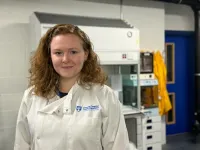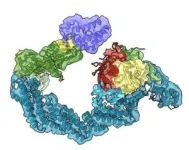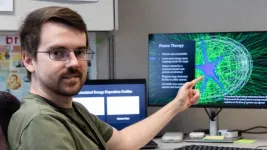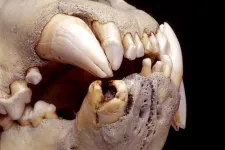(Press-News.org) Hitting the bull’s eye to target ‘undruggable’ diseases – researchers reveal new levels of detail in targeted protein degradation
Targeted protein degradation has opened up a new field of drug discovery with potential to treat previously ‘undruggable’ diseases
Dundee researchers have revealed new levels of details of how protein degraders work
The work means new drugs can be much more accurately targeted at the molecular level, creating and hitting a metaphorical ‘bull’s eye’
Researchers at the University of Dundee have revealed in the greatest detail yet the workings of molecules called ‘protein degraders’ which can be deployed to combat what have previously been regarded as ‘undruggable’ diseases, including cancers and neurodegenerative diseases.
Protein degrader molecules are heralding a revolution in drug discovery, with more than 50 drugs of this type currently being tested in clinical trials for patients with diseases for which no other options exist.
The Centre for Targeted Protein Degradation (CeTPD) at the University of Dundee is one of the world’s leading centres for research into how protein degraders work and how they can most effectively be put to use for a new generation of drugs.
Now researchers have revealed previously invisible levels of detail and understanding of how the protein degraders work, which in turn is allowing for even more targeted use of them at the molecular level.
PhD student Charlotte Crowe, together with Dr Mark Nakasone, Senior Postdoctoral Scientist at CeTPD, used a technique called cryo-electron microscopy (cryo-EM), which enables scientists to see how biomolecules move and interact with each other.
This works by flash-freezing proteins and using a focused electron beam and a high-resolution camera to generate millions of 2D images of the protein. They then used sophisticated software and artificial intelligence (AI) models which allowed them to generate 3D snapshots of the degrader drugs working in action.
Their latest research is published in the prestigious journal Science Advances and is expected to constitute a landmark contribution to research in the field of TPD and ubiquitin mechanisms.
“We have reached a level of detail where we can see how these protein degraders work and can be deployed [to recruit the disease-causing protein ] and target the ‘bull’s eye’, in molecular terms,” said Charlotte Crowe, who carried out the research together with a wider team of Dundee researchers.
“Protein degrader molecules work in a way that is fundamentally different from the way conventional drugs work. However, until recently the exact details of how this process works at the molecular level had remained elusive.
“Proteins are typically a few nanometres large, which is 1 billionth of a metre, or 1 millionth of the width of a hair. So being able to ‘see’ them in action has not been possible, up until now.
“We have now been able to build a moving image of how it all happens, which means we can more specifically control the process with an incredible level of detail.”
Professor Alessio Ciulli, Director of CeTPD and one of the world leaders in the field of targeted protein degradation, said, “This is incredibly exciting work and opens up the possibility of even more effectively targeted drugs able to finally treat some diseases which up until now have been too difficult to tackle.”
How it works
Proteins are essential for our cells to function properly, but when these do not work correctly they can cause disease.
Targeted protein degradation involves redirecting protein recycling systems in our cells to destroy the disease-causing proteins.
Protein degraders work by capturing the disease-causing protein and making it stick like a glue to the cellular protein-recycling machinery, which then tags the protein as expired in order to destroy it.
The tag is a small protein called ubiquitin, which effectively gets fired at the disease-causing protein like a bullet. In order for the process to work effectively, ubiquitin must hit the right spots on the target protein so that it gets tagged effectively. The new work by the Dundee team enables them to see how the bullet hits the proverbial bull’s eye.
Working with a protein degrader molecule called MZ1, which was developed in the Ciulli laboratory at Dundee, and using high-end mass spectrometry, they were able to identify exactly where on the target protein the vital ‘tags’ are added.
The work shows how degrader drugs hold onto and position disease-causing proteins, making them good targets for receiving ubiquitin molecules (ie. "ubiquitin-atable") which then leads to their destruction inside the cell.
Protein degradation efficiency and productivity is dependent on the degrader molecule’s ability to hold tight onto the disease-causing protein, and in a position where it can most effectively act. This latest research paints a bull’s eye and holds it steady enough for the molecule to be accurately targeted.
Professor Ciulli said this and other recently published papers were contributing to rapid development of an exciting field of science and drug discovery.
“This rapidly expanding field is fascinating and complementary articles on how this cellular protein-recycling machinery works to fire ubiquitin molecules at target proteins were recently published by the laboratories of biochemists Brenda Schulman (Max-Planck Institute of Biochemistry) and Gary Kleiger (University of Nevada, Las Vegas).
“Our collective work provides a leap forward in understanding that will accelerate development of new TPD drugs in future”.
The Dundee team
This work comes from a ‘local’ collaboration between two groups of scientists at the University of Dundee.
In the Centre for Targeted Protein Degradation, led by Professor Alessio Ciulli, experts in TPD, were Charlotte Crowe, Mark Nakasone, Conner Craigon, Gajanan Sathe and Nikolai Makukhin.
They worked with Professor Ron Hay, an expert in ubiquitin, based in the School of Life Sciences, and colleagues Sarah Chandler and Mike Tatham.
END
Hitting the bull’s eye to target ‘undruggable’ diseases – researchers reveal new levels of detail in targeted protein degradation
Researchers at the University of Dundee have revealed in the greatest detail yet the workings of molecules called ‘protein degraders’ which can be deployed to combat what have previously been regarded as ‘undruggable’ diseases
2024-10-11
ELSE PRESS RELEASES FROM THIS DATE:
SCAI publishes expert consensus statement on managing patients with ST-elevated myocardial infarction
2024-10-11
WASHINGTON —The Society for Cardiovascular Angiography & Interventions (SCAI) is pleased to announce the publication of the Expert Consensus Statement on the Management of Patients with STEMI Referred for Primary PCI.
Published in JSCAI, the consensus statement provides detailed suggestions for clinicians, particularly for nuanced situations not covered by general guidelines. It highlights the strengths and limitations of various diagnostic and therapeutic interventions for treating patients with STEMI, provides ...
Engineering perovskite materials at the atomic level paves way for new lasers, LEDs
2024-10-11
Researchers have developed and demonstrated a technique that allows them to engineer a class of materials called layered hybrid perovskites (LHPs) down to the atomic level, which dictates precisely how the materials convert electrical charge into light. The technique opens the door to engineering materials tailored for use in next-generation printed LEDs and lasers – and holds promise for engineering other materials for use in photovoltaic devices.
Perovskites, which are defined by their crystalline ...
Kessler Foundation 2024 Survey highlights key strategies for hiring and supporting workers with disabilities in the hospitality industry
2024-10-11
East Hanover, NJ – October 11, 2024 – A new Kessler Foundation survey of supervisors in the hospitality industry – focused on restaurant and traveler accommodations – has revealed critical insights into the recruitment, support, and accommodation of workers with disabilities. The findings, released today in a special live Zoom webinar, offer actionable takeaways for employers looking to diversify their workforce and enhance workplace inclusion. Key points revealed that proactive recruitment, effective partnerships, and ...
Harnessing protons to treat cancer
2024-10-11
NEWPORT NEWS, VA – Radiation therapy techniques have been used for more than a century to treat cancers. Physicists in the Radiation Detector and Imaging group and associated with the Biomedical Research & Innovation Center (BRIC) at the U.S. Department of Energy’s Thomas Jefferson National Accelerator Facility have been for several years pursuing radiation therapy technology improvements in collaboration with the Hampton University Proton Cancer Institute (HUPCI). Now, BRIC physicists are launching a study into how best to advance different types of radiation therapy.
BRIC scientists plan to evaluate the ability of accelerator-based ...
Researchers identify neurodevelopmental symptoms that indicate genetic disorders
2024-10-11
In a new study, UCLA Health researchers have found that motor delay and low muscle tone were common signs of an underlying genetic diagnosis in children with neurodevelopment disorders.
Given the limited existing data on the early neurodevelopmental symptoms that predict a positive genetic diagnosis, the study authors aimed to research which factors in this subset of children indicated the need of a genetic test. “With genetic testing, a diagnostic result can have benefits on medical care, but ...
Electronic nudges to increase influenza vaccination in patients with chronic diseases
2024-10-11
About The Study: In a nationwide randomized clinical implementation trial, electronically delivered letter-based nudges markedly increased influenza vaccination compared with usual care among young and middle-aged patients with chronic diseases. The results of this study suggest that simple, scalable, and cost-efficient electronic letter strategies may have substantial public health implications.
Corresponding Author: To contact the corresponding author, Tor Biering-Sorensen, MD, MSc, MPH, PhD, email tor.biering@gmail.com.
To access the embargoed ...
Plant stem cells: Better understanding the biological mechanism of growth control
2024-10-11
Plants form new leaves, flowers and roots at the tips of shoots and roots, in specific growth regions known as meristems. These meristems contain stem cells that divide as needed and form new cells that develop into specialised tissue. Using the example of plant roots, researchers from Freiburg have now been able to decipher which regulatory mechanisms ensure that growth in the meristem occurs in a controlled manner. The results have been published in the journal Nature Plants.
Stem cells are dependent on ...
Genomic study identifies human, animal hair in ‘man-eater’ lions’ teeth
2024-10-11
CHAMPAIGN, Ill. — In 1898, two male lions terrorized an encampment of bridge builders on the Tsavo River in Kenya. The lions, which were massive and maneless, crept into the camp at night, raided the tents and dragged off their victims. The infamous Tsavo “man-eaters” killed at least 28 people before Lt. Col. John Henry Patterson, the civil engineer on the project, shot them dead. Patterson sold the lions’ remains to the Field Museum of Natural History in Chicago in 1925.
In a new study, Field Museum researchers collaborated with scientists at the University of Illinois Urbana-Champaign on an in-depth analysis of hairs carefully extracted ...
These 19th century lions from Kenya ate humans, DNA collected from hairs in their teeth shows
2024-10-11
By isolating and sequencing DNA in compacted hairs collected from the teeth of two Tsavo lion museum specimens from the 1890s, researchers have found that the historic lions from Kenya preyed on a variety of species, including humans, giraffes, and wildebeests. These so-called “Tsavo Man-Eaters” are estimated to have killed at least dozens of people, including those working along the Kenya-Uganda Railway in the late 1890’s. The findings appear in the Cell Press journal Current Biology on October 11.
“As ...
A potential non-invasive stool test and novel therapy for endometriosis
2024-10-11
Promising findings by researchers at Baylor College of Medicine and collaborating institutions could lead to the development of a non-invasive stool test and a new therapy for endometriosis, a painful condition that affects nearly 200 million women worldwide. The study appeared in the journal Med.
“Endometriosis develops when lining inside the womb grows outside its normal location, for instance attached to surrounding intestine or the membrane lining the abdominal cavity. This typically causes bleeding, pain, inflammation and infertility,” said corresponding author Dr. Rama Kommagani, associate professor in the Department of Pathology ...
LAST 30 PRESS RELEASES:
Longest observation of an active solar region
Why nail-biting, procrastination and other self-sabotaging behaviors are rooted in survival instincts
Regional variations in mechanical properties of porcine leptomeninges
Artificial empathy in therapy and healthcare: advancements in interpersonal interaction technologies
Why some brains switch gears more efficiently than others
UVA’s Jundong Li wins ICDM’S 2025 Tao Li Award for data mining, machine learning
UVA’s low-power, high-performance computer power player Mircea Stan earns National Academy of Inventors fellowship
Not playing by the rules: USU researcher explores filamentous algae dynamics in rivers
Do our body clocks influence our risk of dementia?
Anthropologists offer new evidence of bipedalism in long-debated fossil discovery
Safer receipt paper from wood
Dosage-sensitive genes suggest no whole-genome duplications in ancestral angiosperm
First ancient human herpesvirus genomes document their deep history with humans
Why Some Bacteria Survive Antibiotics and How to Stop Them - New study reveals that bacteria can survive antibiotic treatment through two fundamentally different “shutdown modes”
UCLA study links scar healing to dangerous placenta condition
CHANGE-seq-BE finds off-target changes in the genome from base editors
The Journal of Nuclear Medicine Ahead-of-Print Tip Sheet: January 2, 2026
Delayed or absent first dose of measles, mumps, and rubella vaccination
Trends in US preterm birth rates by household income and race and ethnicity
Study identifies potential biomarker linked to progression and brain inflammation in multiple sclerosis
Many mothers in Norway do not show up for postnatal check-ups
Researchers want to find out why quick clay is so unstable
Superradiant spins show teamwork at the quantum scale
Cleveland Clinic Research links tumor bacteria to immunotherapy resistance in head and neck cancer
First Editorial of 2026: Resisting AI slop
Joint ground- and space-based observations reveal Saturn-mass rogue planet
Inheritable genetic variant offers protection against blood cancer risk and progression
Pigs settled Pacific islands alongside early human voyagers
A Coral reef’s daily pulse reshapes microbes in surrounding waters
EAST Tokamak experiments exceed plasma density limit, offering new approach to fusion ignition
[Press-News.org] Hitting the bull’s eye to target ‘undruggable’ diseases – researchers reveal new levels of detail in targeted protein degradationResearchers at the University of Dundee have revealed in the greatest detail yet the workings of molecules called ‘protein degraders’ which can be deployed to combat what have previously been regarded as ‘undruggable’ diseases





